Overview
Located at the northwest of Gansu Province and bordering with Xinjiang Uygur Autonomous Region and Qinghai Province, Dunhuang is an oasis town under the administration of Jiuquan City (where China Satellite Launch Center is based). It covers an area of 31,2 square kilometers with a population of 130,000.
Dun in Chinese means grand, Huang means prosperity. During Han and Tang Dynasty, it was a major point of interchange between China and the outside world ? a stopping-off post for both incoming and outgoing trading caravans. Dunhuang was made a prefecture in 117 BC by Emperor Han Wud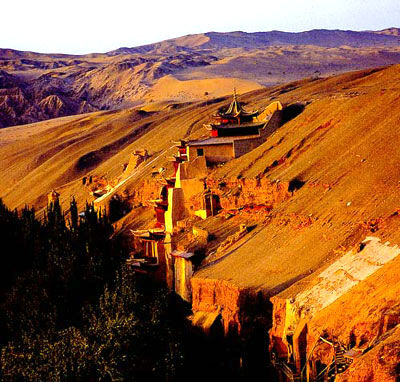 i. Located near the historic junction of the northern and southern Silk Roads, it was a town of military importance.
i. Located near the historic junction of the northern and southern Silk Roads, it was a town of military importance.
For centuries Buddhist monks at Dunhuang collected scriptures from the west, and many pilgrims passed through the area, painting murals inside the Mogao Caves or Caves of a Thousand Buddhas. A small number of Christian artifacts have also been found in the caves, evidence to the people from Europe who made their way along the Silk Road. Today, the site is a popular tourist attraction and the subject of an ongoing archaeological project.
Dunhuang lives on agriculture. In recent years, tourism is booming fast and becomes a new economic propeller. Dunhuangs city centre is relatively highly developed, including much commercial activity and many hotels. Bookshops and other souvenir shops sell materials relating to the Caves and the history of the region. A night market is held in the city centre, popular with tourists. Many souvenir items are sold, including such typical items as jade, jewelry, scrolls, hangings, small sculptures, and the like.
Attractions
Mogao Caves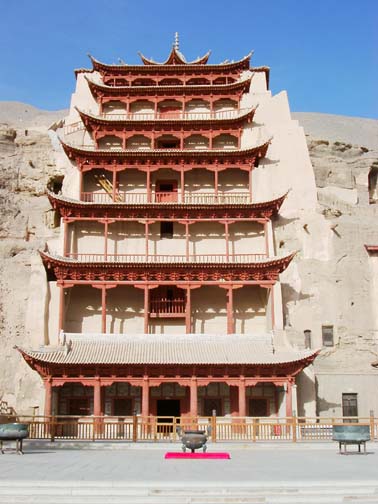
Located 25 kilometers southeast of Dunhuang, Mogao Caves is regarded as the premier Buddhist spot in China, perhaps in the whole world. The artistic features of the treasured Buddhist murals represent perfectly the artistic style of the Northern Wei (386-543), Sui (581-618) and Tang (618-907) dynasties through the combination of the architecture, statues and murals in the caves. Presently, there are about ten caves and two exhibition centers open to the public, occasionally more during public holidays.
Echoing-Sand Mountain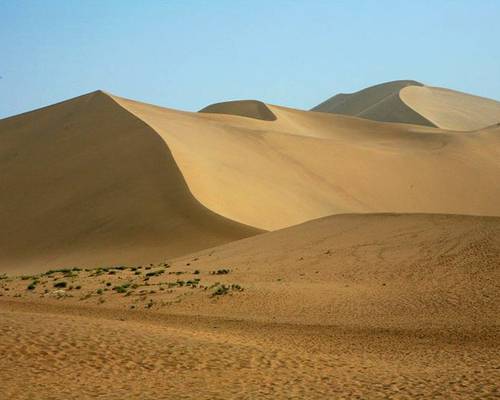
Five kilometers south of Dunhuang City, Echoing-Sand Mountain is the accumulation of years of sand in the size of rice. Each time the wind blows, there is a sound from the mountain and when there is a breeze, the sound is like musical instruments, hence the name. The most marvelous experience is when after climbing to the top, although quite strenuous, one can slide down to the foot of the mountain, a wonderfully amusing experience!

Crescent Lake
Five kilometers southwest of Dunhuang, the Crescent Lake lies in the arms of Echoing-Sand Mountain, appearing clear and beautiful. The lake is crescent-shaped, hence the name. It’s surrounded by quicksand. Although it’s quite windy sometimes, the lake has never been covered by the sand. It’s really a marvelous spectacle in the desert.
Yangguan Pass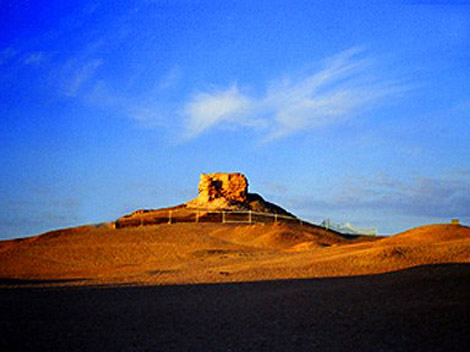
Located 70 kilometers (about 43.5 miles) southwest of Dunhuang, the Yangguan Pass is the gateway to the south western region on the way to the Silk Road. The beacon tower is all that remains of the Pass. Near the Yangguan Pass is Nanhu, a local grape producing area and Grape Gallery. Tourists can sit on the stone benches, sample the sweet grapes and wander through the gallery to learn about local folk-customs.
Yumengua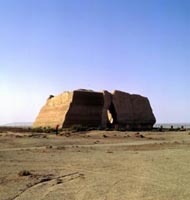 n Pass
n Pass
Situated 90 kilometers (about 55.9 miles) northwest of Dunhuang City, the Yumen Pass was an important gateway to the western region in ancient times. Yumen Pass, Hecang Town and Han Great Wall (Han Dynasty), are the major sights in this area. Since the Yangguan Pass and the Yumen Pass are a distance from Dunhuang, one can have a feel for the desolation of western China. Yangguan Pass is relatively closer to the city and a comparatively smoother ride. Taxis can be hired for the hour drive and it is wise to stay away from minibuses, as the fare is greater.
Dining
Camel Hoof on Silk Road
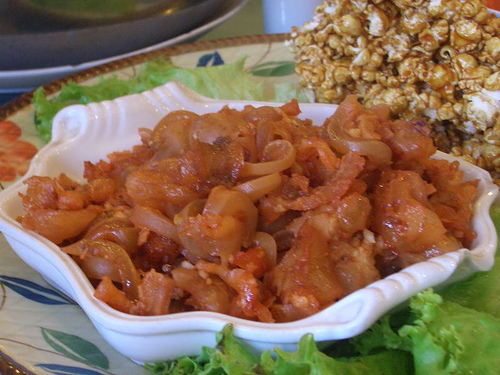 A dish, also known as Camel Hoof on Jokul, gained its name for the shape that is like camel prints on the Jokul. It is a known fact that the camel is the most important means of transportation along the ancient Silk Road. They can travel across the arid desert for great distances, aided by their four broad feet. Camel Hoof is actually tendon, and is highly nutritious. People hardly ever kill camels, and with its long life span, the hoof is difficult to find, and is almost as precious as bear palm. To prepare the hoof, clean and marinate it in water until soft, then flavor with some seasoning and steam it together with a chicken for seven or eight hours till the bones can be easily removed. Cut the hoof into pieces, add flavors braised in bamboo steamer for two or three hours. Finally, use egg white to make the jokul, put them together and make a shape of camel hoof on Jokul.
A dish, also known as Camel Hoof on Jokul, gained its name for the shape that is like camel prints on the Jokul. It is a known fact that the camel is the most important means of transportation along the ancient Silk Road. They can travel across the arid desert for great distances, aided by their four broad feet. Camel Hoof is actually tendon, and is highly nutritious. People hardly ever kill camels, and with its long life span, the hoof is difficult to find, and is almost as precious as bear palm. To prepare the hoof, clean and marinate it in water until soft, then flavor with some seasoning and steam it together with a chicken for seven or eight hours till the bones can be easily removed. Cut the hoof into pieces, add flavors braised in bamboo steamer for two or three hours. Finally, use egg white to make the jokul, put them together and make a shape of camel hoof on Jokul.
Stir-fried Hump with Five Shredding
This traditional Dunhuang dish was a favorite of high-ranking imperial concubine Yang Yuhuan of the Tang Dynasty (618-907). The primary ingredient is Camel hump, accompanied with five shredding consists of Yulan (dryed bamboo shoot), Dongru (a type of mushroom), leek shoots, ham and chicken breast. It is featured in fat and the soft meat.
Quick-frying Hump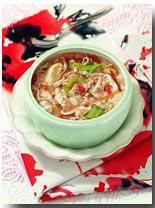
Cut the Camel hump into regular pieces or shredding and quick-fry them. Flavor with seasonings, and voila the finished fresh, soft and tasteful Quick-frying Hump.
Fry Oil Cake
Stuffed sugar candy, rose-essence, walnut and sesame in an oil flour skin that are rounded, and then fried. The cake tastes fragrant, sweet and crisp.
Yellow Noodles
It is a kind of Lamian (dough stretched to form fine noodles). Yellow Noodles look like golden threads, tastes delicious and have a soft texture. They can be added to soups, or mixed with cooked vegetable dishes, and being savoury, makes a good appetitive. From the vivid painting in the Mogao Caves, we may know Lamian is a traditional food with long history.
Niang Pi Zi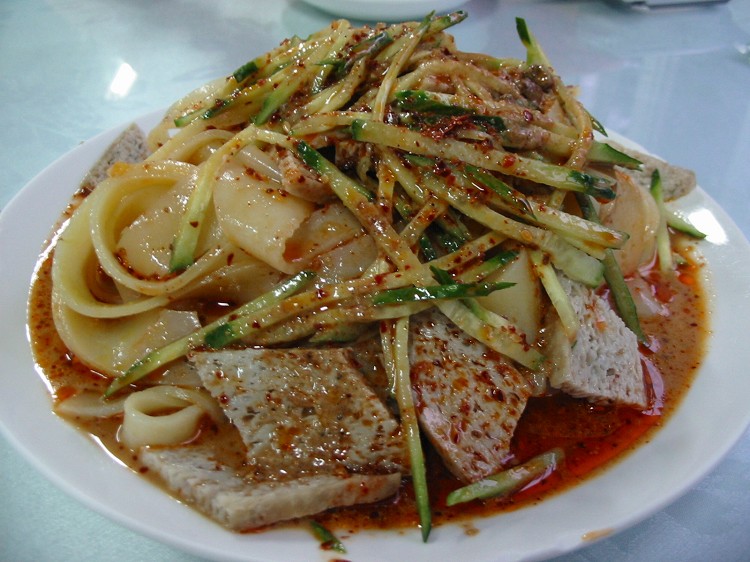
It is a kind of traditional popular fast food that is both a little spicy and vinegary. Mix flour and water together into a bowl, then ladle the mixture onto an iron plate, after steaming one minute, the mixture become a wafer thin cake. Cut the cake into strips, leave until cool and flavor with mustard, garlic, capsicum, sauce and vinegar. It is similar to the tasteful Liang Pi of Xian.
Apricot Peel Water
It is a popular drink in Dunhuang City, with a sweet and sour taste like syrup of Plum. It is the cooled boiling water of dry apricot, which is very refreshing, especially for tourists.
Shazhou Night Market on Yangguan East Road is the best place to try these local flavors, such as lamb shashliks and Lanzhou (the capital city of Gansu Province) Lamian (a kind of noodles).
Shopping
Dunhuang City is a favorite tourist city in China, but not a modern city and it maybe a little difficult to find large, luxurious emporiums or supermarkets here. In spite of this, tourists will find handcrafts, gifts and souvenirs readily available in Dunhuang City. Dunhuang City was called Gua (melon) Zhou in ancient times, meaning the hometown of fruits. Dunhuang City is teeming with many kinds of fragrant sweet fruits; some excellent kinds are particular to Dunhuang City that you may not find in other places.
Handcrafts of carpet, painted sculpture, craftworks of camels, luminous cup, calligraphy and painting and Dunhuang wax printing, etc are the most famous. Luminous Cup, known as a Yangguan Jade Cup, is a rare drinking vessel that glows in the dark, hence the name. The cup is made of the fine jade quarried from Mt. Qilian containing abundant mineral substances. Using the cup to drink is good for peoples health. Camels are the most important animal for transportation on ancient Silk Road, which is called the pride of desert and people venerate its grittiness and hardworking, make flannelette effigies of it. It has been taken as the mascot of the China Art Festival. Now it is a specialty local tourist souvenir.